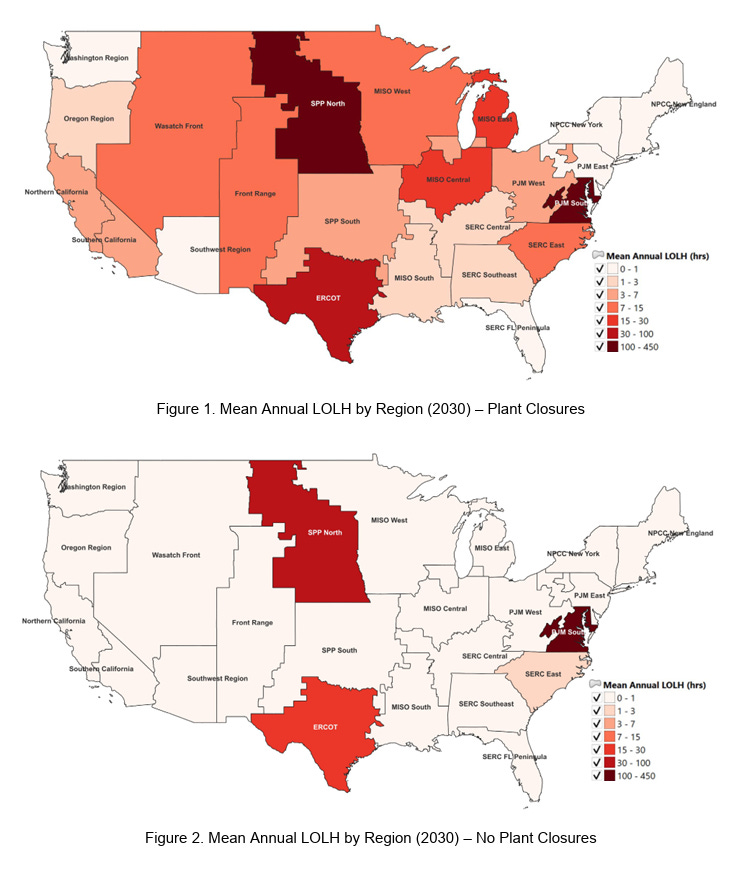“...𝙩𝙝𝙚 𝙉𝙖𝙩𝙞𝙤𝙣’𝙨 𝙥𝙤𝙬𝙚𝙧 𝙜𝙧𝙞𝙙 𝙬𝙞𝙡𝙡 𝙗𝙚 𝙪𝙣𝙖𝙗𝙡𝙚 𝙩𝙤 𝙢𝙚𝙚𝙩 𝙥𝙧𝙤𝙟𝙚𝙘𝙩𝙚𝙙 𝙙𝙚𝙢𝙖𝙣𝙙 𝙛𝙤𝙧 𝙢𝙖𝙣𝙪𝙛𝙖𝙘𝙩𝙪𝙧𝙞𝙣𝙜, 𝙧𝙚-𝙞𝙣𝙙𝙪𝙨𝙩𝙧𝙞𝙖𝙡𝙞𝙯𝙖𝙩𝙞𝙤𝙣, 𝙖𝙣𝙙 𝙙𝙖𝙩𝙖 𝙘𝙚𝙣𝙩𝙚𝙧𝙨 𝙙𝙧𝙞𝙫𝙞𝙣𝙜 𝙖𝙧𝙩𝙞𝙛𝙞𝙘𝙞𝙖𝙡 𝙞𝙣𝙩𝙚𝙡𝙡𝙞𝙜𝙚𝙣𝙘𝙚 (𝘼𝙄) 𝙞𝙣𝙣𝙤𝙫𝙖𝙩𝙞𝙤𝙣 [𝙖𝙗𝙨𝙚𝙣𝙩 𝙙𝙚𝙘𝙞𝙨𝙞𝙫𝙚 𝙞𝙣𝙩𝙚𝙧𝙫𝙚𝙣𝙩𝙞𝙤𝙣]...”
That was the conclusion of a recent report from the DOE “Evaluating the Reliability and Security of the United States Electric Grid”.
The combination of planned retirements of firm power capacity, new generation concentrated on wind and solar generation, and load growth (from AI data centers as well as other load drivers) “𝗶𝗻𝗰𝗿𝗲𝗮𝘀𝗲 𝘁𝗵𝗲 𝗿𝗶𝘀𝗸 𝗼𝗳 𝗽𝗼𝘄𝗲𝗿 𝗼𝘂𝘁𝗮𝗴𝗲𝘀 𝗯𝘆 𝟭𝟬𝟬𝘅 𝗶𝗻 𝟮𝟬𝟯𝟬” in the DOE’s analysis.
Consider the Loss of Load Hours (LOLH) metric, which measures the expected duration of power outages when a system's load exceeds its available generation capacity. Based on a "1-in-10 year" reliability standard for electricity grids, on average, there should be no more than one day (24 hours) of lost load over a ten-year period. This translates to a maximum of 2.4 hours of lost load per year.
In the DOE’s “Plant Closures” scenario, which combines 104 GW of announced retirements (~71 GW of coal and ~25 GW of natural gas) and 209 GW of additions (20GW of natural gas, 31 GW of 4-hour batteries, 124 GW of solar and 32 GW of wind) 𝗺𝗼𝘀𝘁 𝗿𝗲𝗴𝗶𝗼𝗻𝘀 𝗮𝗿𝗲 𝗹𝗶𝗸𝗲𝗹𝘆 𝘁𝗼 𝗳𝗶𝗻𝗱 𝘁𝗵𝗲𝗺𝘀𝗲𝗹𝘃𝗲𝘀 𝘄𝗶𝘁𝗵 𝗟𝗢𝗟𝗛 𝘄𝗲𝗹𝗹 𝗮𝗯𝗼𝘃𝗲 𝘁𝗵𝗲 “𝟭-𝗶𝗻-𝟭𝟬 𝘆𝗲𝗮𝗿” 𝘁𝗵𝗿𝗲𝘀𝗵𝗼𝗹𝗱 𝗯𝘆 𝟮𝟬𝟯𝟬.
In contrast, if retirements are delayed, or that capacity is replaced 1-for-1 (in addition to the other additions), the picture looks much better.
But 2030 is not that far off, in infrastructure construction time. 𝗪𝗵𝗮𝘁 𝗺𝗼𝗿𝗲 𝗰𝗮𝗻 𝗴𝗲𝘁 𝗯𝘂𝗶𝗹𝘁, 𝗮𝗻𝗱 𝗵𝗼𝘄 𝗺𝘂𝗰𝗵 𝗰𝗮𝗻 𝘁𝗵𝗼𝘀𝗲 𝘁𝗶𝗺𝗲𝗹𝗶𝗻𝗲𝘀 𝗴𝗲𝘁 𝗮𝗰𝗰𝗲𝗹𝗲𝗿𝗮𝘁𝗲𝗱?



What has to change is the irresponsible closure of base load facilities without a plan to replace them with resources having similar load serving ability. Energy is not power. Never is, never will be.
So an acceleration of capacity adds to the end of the decade?